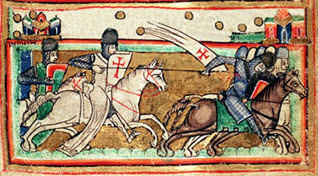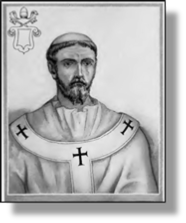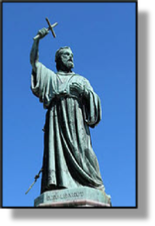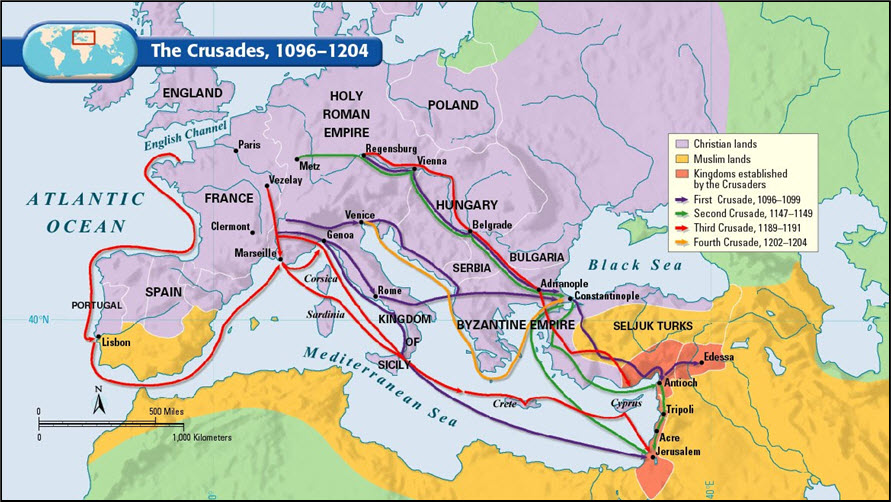


THE FIRST CRUSADE 1095 -
xxxxxThe Holy Land had been occupied by Arab Muslims since the seventh century but, over the years, they had shown a remarkable degree of tolerance towards the thousands of Christian pilgrims who made their way to Jerusalem each year. Towards the end of the eleventh century, however, all this changed. Ardent Muslims known as Seljuk Turks moved southwards into Asia Minor and, defeating the Byzantines at the Battle of Manzikert in 1071 (W1), moved into Palestine and took control of Jerusalem. Christians were ill-
Including:
Pope Urban II

 xxxxxThe Arab Muslims had occupied the Holy Land since the seventh century when the followers of Islam had conquered the Middle East, swept along the north coast of Africa, and invaded southern Europe by way of Spain and Sicily. Over the years, however, they had shown a great deal of tolerance towards the thousands of Christian pilgrims who each year flooded into Palestine and made their way to Jerusalem, the holy city where their Saviour had been crucified and, according to their faith, had risen from the dead. Such tolerance may well have been motivated in part by the large income the Arabs received from the feeding and housing of these visitors, but it was nonetheless commendable.
xxxxxThe Arab Muslims had occupied the Holy Land since the seventh century when the followers of Islam had conquered the Middle East, swept along the north coast of Africa, and invaded southern Europe by way of Spain and Sicily. Over the years, however, they had shown a great deal of tolerance towards the thousands of Christian pilgrims who each year flooded into Palestine and made their way to Jerusalem, the holy city where their Saviour had been crucified and, according to their faith, had risen from the dead. Such tolerance may well have been motivated in part by the large income the Arabs received from the feeding and housing of these visitors, but it was nonetheless commendable.
xxxxxTowards the end of the eleventh century, however, all this changed. The Seljuk Turks, ardent Muslims, began to move southwards into Asia Minor. In 1071 (W1), they defeated the Byzantines at the Battle of Manzikert and, sweeping into Palestine, overpowered the Saracens and took control of Jerusalem. Thenxin 1085, under their leader Malik Shah, they sei zed the port of Antioch and began blocking the routes whereby Christians made their way to the Holy City. Pilgrims themselves were ill-
zed the port of Antioch and began blocking the routes whereby Christians made their way to the Holy City. Pilgrims themselves were ill-
xxxxxThe Pope's plea for armed intervention aroused a colossal response. People from all walks of life flocked to the banner of Christ, bearing the red cross which symbolised the crucified Christ and -

xxxxxThe Crusade was made up of two forces. The first was nothing short of a rabble and came to be known as the People's Crusade. Little prepared, if at all, for the long journey they faced and the enemy they were to meet, this mob was mostly made up of peasants and vagabonds who had never been outside their feudal homesteads but had been persuaded to take up arms -
xxxxxThexsecond force was a well organised army by the standards of the day, well equipped and led by many European princes, including Robert Duke of Normandy, son of William the Conqueror, and Godfrey de Bouillon, Duke of Lower Lorraine. It arrived at Constantinople in 1097 and was soon embarked on a series of savage battles. It took Antioch in 1098, and then in July of the following year, after a siege lasting a month, captured its greatest prize, the Holy City of Jerusalem. A new kingdom was formed known as the Kingdom of Jerusalem and Duke Godfrey became its first leader with the title Defender of the Holy Sepulchre. It must then have seemed that the battle against the Infidel was over, but, in fact, as we shall see (1147 ST), this Crusade was to be but the first of many despatched over the next 200 years. The Saracens were not to be that easily dislodged from the Christian lands of the Middle East and their own sacred city of Jerusalem.
Acknowledgements
Crusade: medieval illustration, artist unknown. Urban II: illustration from The Lives and Times of the Popes by the French diplomat and historian Artaud de Montor (1772-
W2-
malik
Clermont




